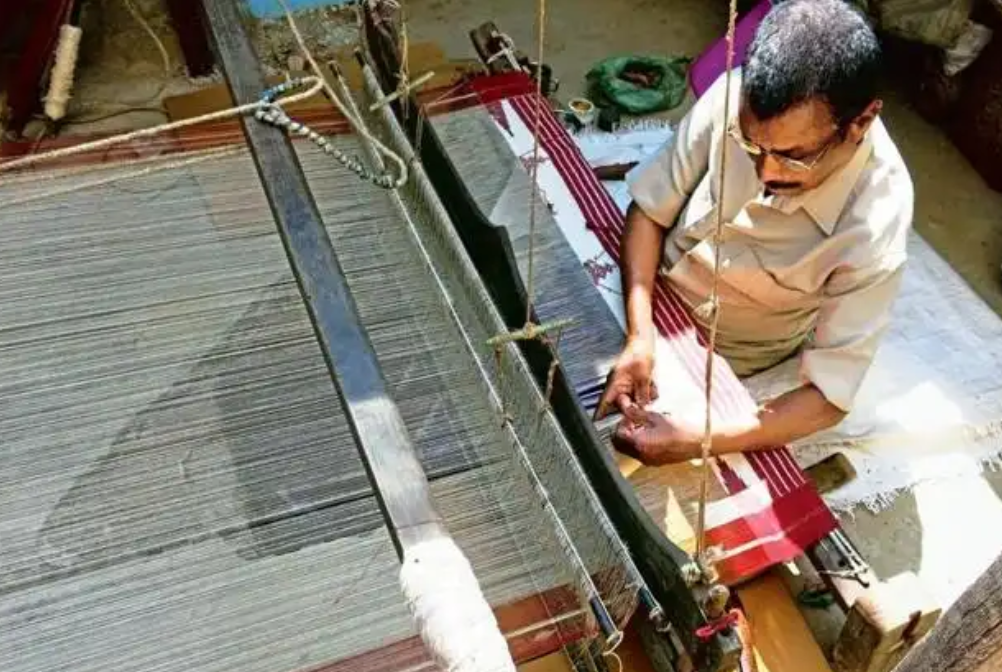Kotpad: Padmashree Gobardhan Panika belongs to the small town of Kotpad in Koraput district. He is a handloom weaver par excellence, who won the National Award in 2004, the Sant Kabeer Award in 2015 and Padmashree in 2018. He also weaves exclusive patterns on sarees, shawls and scarves against his name and has showcased his exhibits around the country.
Panika always credits his wife, who has been with him in all his ups and downs for his work. He said that Kotpad dyeing is entirely organic, manual, labour intensive and a long process, which may explain why the work rests solely on the shoulders of women.
Jemamani Panika is well known for her colouring and curing of threads. She is also a National Award winner in handloom weaving. She lends a big helping hand to her husband Panika in producing the master pieces.
But the women who embody the essence of the rich-hued Kotpad weave get the least credit for their role in the century old tradition.
“I wonder if the weavers of Kotpad textiles know hard we work to create those colours.” She says youngsters have lost interest in this craft and cheaper chemical dyes have taken the market.
Yet the women dyers who give the Kotpad weave their distinctive look rarely get recognition. Their work is not even seen as craft because the focus is limited to the finished product and not the dyeing of the yarn.
At the village pond, women were washing the treated and dyed yarn, slapping it on rocks, kneading it over and over with their hands and feet. After a month of labour the threads change from the original cream to dramatic reds, maroons, rusty pinks, coffee browns and deep blacks.
The dyed threads are then handed over to Kotpad’s male weavers. Working on pit looms they turn these into elegant saris which were originally sold in the Adivasi markets of Koraput and Jagdalpur districts and now in urban markets and exhibitions and on e-commerce sites.
Sari prices start from Rs 3,500 to Rs 12,000 and more depending on the quality of the yarn used and the intricacy of the woven design.
The town’s unique contribution to India’s textile heritage is now endangered in spite of the geographical indication (GI) tag.
The bark of the Aal (madder) tree which Kotpad dyers use to produce exquisite hues dry outside mud homes in the mirigan sai (weaver’s section) of the town. Powder solution bubbling over firewood bundles of yarn which they had treated with cow dung and castor oil were being lowered into the steaming dark concoction.
Here and there rows of cream and maroon yarn in various stages of treatment and dyeing hang from bamboo frames, with women checking on their readiness for the next stage of work.
Mamta Jain, a resident of Jeypore and a customer of Kotpad handloom, saree said the Kotpad brick reds are among the most beautiful organically dyed reds in Indian handlooms, and the dyeing process of the women here is the best in the country.
“But there is very little recognition for the women who have retained the integrity of this traditional skill for over a century and who continue to create these exquisite colours,” she added.
“Women’s labour and skills are grossly undervalued,” says Prahollada Mahanto, president of the Kotpad Weavers’ Cooperative Society, which was set up in 1956 to represent the dyers and weavers.
He says most women dyers make only around Rs 4,000- Rs 5,000 a month. During monsoon, when the dyeing work comes to a stop in the absence of bright sunshine, several women work as casual labour.
Today Kotpad has a mere 30-40 women dyers and 15-20 households engaged in weaving, compared to the over 100 households around two-three decades ago, according to Mahanto.
“Unless the government intervenes to support them and help train young women this art will soon vanish,” he says.
PNN

